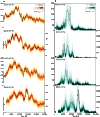Rainfall regimes of the Green Sahara
- PMID: 28116352
- PMCID: PMC5242556
- DOI: 10.1126/sciadv.1601503
Rainfall regimes of the Green Sahara
Abstract
During the "Green Sahara" period (11,000 to 5000 years before the present), the Sahara desert received high amounts of rainfall, supporting diverse vegetation, permanent lakes, and human populations. Our knowledge of rainfall rates and the spatiotemporal extent of wet conditions has suffered from a lack of continuous sedimentary records. We present a quantitative reconstruction of western Saharan precipitation derived from leaf wax isotopes in marine sediments. Our data indicate that the Green Sahara extended to 31°N and likely ended abruptly. We find evidence for a prolonged "pause" in Green Sahara conditions 8000 years ago, coincident with a temporary abandonment of occupational sites by Neolithic humans. The rainfall rates inferred from our data are best explained by strong vegetation and dust feedbacks; without these mechanisms, climate models systematically fail to reproduce the Green Sahara. This study suggests that accurate simulations of future climate change in the Sahara and Sahel will require improvements in our ability to simulate vegetation and dust feedbacks.
Keywords: Climate Change; Climate Modeling; Green Sahara; Hydrogen Isotopes; Leaf Waxes; Paleoclimate.
Figures





References
-
- Gasse F., Hydrological changes in the African tropics since the Last Glacial Maximum. Quat. Sci. Rev. 19, 189–211 (2000).
-
- Hoelzmann P., Keding B., Berke H., Kröpelin S., Kruse H.-J., Environmental change and archaeology: Lake evolution and human occupation in the Eastern Sahara during the Holocene. Palaeogeogr. Palaeoclimatol. Palaeoecol. 169, 193–217 (2001).
-
- Kuper R., Kröpelin S., Climate-controlled Holocene occupation in the Sahara: Motor of Africa’s evolution. Science 313, 803–807 (2006). - PubMed
-
- deMenocal P. B., Plio-Pleistocene African climate. Science 270, 53–59 (1995). - PubMed
-
- Kutzbach J. E., Monsoon climate of the early Holocene: Climate experiment with the Earth’s orbital parameters for 9000 years ago. Science 214, 59–61 (1981). - PubMed
LinkOut - more resources
Full Text Sources
Other Literature Sources

